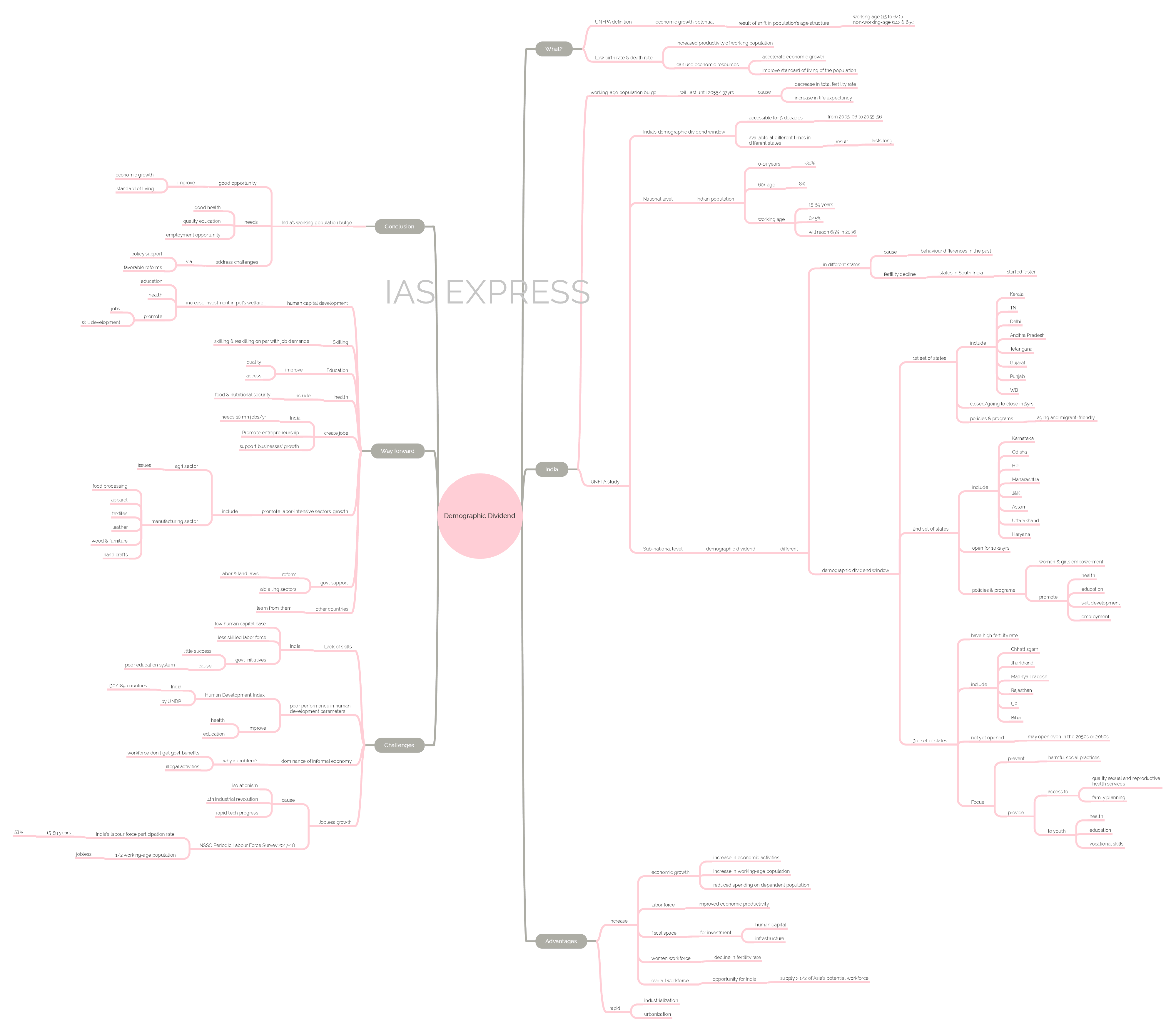Demographic Dividend in India – Benefits, Challenges & Opportunities

Since 2018, India’s working-age population has grown larger than the dependent population consisting of children and senior citizens. This youth bulge is going to last for 37 years. However, the current economic slowdown has led to layoffs, growth decline in various sectors and joblessness. Necessary steps like policy support and reforms must be taken to make full utilisation of India’s demographic dividend to promote the growth and development of the economy.
This topic of “Demographic Dividend in India – Benefits, Challenges & Opportunities” is important from the perspective of the UPSC IAS Examination, which falls under General Studies Portion.
What is the demographic dividend?
- United Nations Population Fund (UNFPA) defines demographic dividend as “the economic growth potential that can result from shifts in a population’s age structure, mainly when the share of the working-age population (15 to 64) is larger than the non-working-age share of the population (14 and younger, and 65 and older)”.
- It is a concept wherein a country that experiences low birth rates in conjunction with low death rates receives an economic dividend i.e., the benefit from the increase in productivity of the working population.
- With low birth rates, the number of the working-age population becomes higher than that of the young dependent population, leading to fewer people to support and more people in the labour force.
- This allows the economic resources to be used for other areas to accelerate a country’s economic growth and improved the standard of living of the population.
In India:
- This bulge in the working-age population is going to last until 2055, or 37 years from its beginning.
- This transition is mainly due to a decrease in the Total Fertility Rate (number births per woman) after the increase in life expectancy has become stable.
- A study on India’s demographic dividend by UNFPA found that:
- The window of demographic dividend opportunity in India is accessible for 5 decades – between 2005-06 and 2055-56. This is longer than any other country in the world.
- This demographic dividend window is available at different times in different states due to the differential behaviour of the population parameters.
National Level:
- Currently, India has a large proportion of the population that is young.
- About 30% of India’s population is in the age group of 0-14 years.
- The elderly in the 60-plus age group is still a small proportion (8%) of the country’s population.
- The working-age group (15-59 years) accounts for 62.5% of India’s population.
- It is estimated that the working-age population will reach the highest proportion of approximately 65% in 2036.
Sub-national level:
- As previously mentioned, the demographic dividend at the sub-national level is not available in all states at the same time.
- This is because different states have behaved differently in the past and are estimated to behave differently in terms of population parameters in the future also.
- Firstly, fertility decline across states and regions have been different.
- Some states, especially those in southern India, started seeing a decline in the fertility rate earlier than other states, especially those in the hinterland.
- This created regional variations in the degrees and timings of fertility decline and a clear pattern of demographic divergence have emerged in India.
- It is found that northern India is younger, while the southern and western states are maturing.
- In UNFPA’s study, it was found that three sets of states would have their windows of demographic dividend available at different periods.
- The first set of states are in southern and western parts of India. These include Kerala, Tamil Nadu, Delhi, Andhra Pradesh, Telangana, Gujarat, Punjab and West Bengal. For these states, the window of demographic dividend opportunity has either closed or is about to in the next five years.
- The second set of states has a window of the demographic dividend that will remain open for another 10 to 15 years. These states include Karnataka, Odisha, Himachal Pradesh, Maharashtra, Jammu and Kashmir, Assam, Uttarakhand and Haryana.
- The third set of states includes the high-fertility states in the hinterland of India. These include Chhattisgarh, Jharkhand, Madhya Pradesh, Rajasthan, Uttar Pradesh and Bihar. The window of demographic dividend opportunity is yet to open in these states. They may have it even in the 2050s or 2060s.
- This study shows that India will enjoy a longer span of the demographic dividend because, as the window closes in some states, it will open in others.
- This is an important finding as it can guide the socio-economic development policy planning according to the age and sex structures in states or a set of states.
- With this in mind, UNFPA advocates a differential approach in policymaking and programme planning to harness the demographic dividend opportunity.
- For instance, the focus on the states where the window is closing soon will have to be on ageing and migrant-friendly policies and programmes.
- For the states where the window is open and will close in the next 10-15 years, the focus should be on empowering girls and women, promotion of health, education and skill development for young people, and employment generation.
- The focus in the states where the window is yet to open will have to be threefold:
- Address harmful practices like child marriage,
- Provide access to quality sexual and reproductive health services and family planning for all, and
- Promote health, education, life and vocational skills to the younger population.
What are the advantages of the demographic dividend?
- Increase in economic growth because of the increase in economic activities of the higher working-age population and the reduced spending on the dependent population.
- Increase in labour force improves the economy’s productivity
- Increased fiscal space because of the demographic dividend allows for the diverting of resources meant for children and older population to invest in human capital and infrastructure.
- Increase in women workforce because of the decline in fertility rate allows for an increase in economic growth.
- Increase in the overall workforce allows India to supply more than half of Asia’s potential workforce in the coming decades. The demographic dividend has historically provided about 15% of the overall growth of the advanced economies.
- Fast-paced industrialisation and urbanisation due to increased number of job-seeking population. This would force the country towards higher economic activities.
What are the challenges associated with the demographic dividend in India?
- Lack of skills: Skilling and reskilling are vital in current times because of the increasing new fields and opportunities. India may not be able to take advantage of the opportunities because of a low human capital base and less skilled labour force. Government initiatives like Skill India did little to improve the situation because of the poor education system in the country.
- Poor performance in human development parameters: India ranks 130 out of 189 countries in the Human Development Index published by the UN Development Programme (UNDP). Improvement in health and education is vital for India to utilise its demographic dividend.
- The dominance of the informal economy: Most of the labour force in India is employed in the informal economy. This is a hindrance to India’s economic growth as the workforce do not get the intended benefits from the government. The other issues pertaining to the informal economy include labour exploitation, black money, money laundering, and other illegal activities.
- Jobless growth: There is a growing concern about the jobless growth of the Indian economy because of the current trend of isolationism in the global economy, the emergence of the fourth industrial revolution and rapid technological progress. According to the NSSO Periodic Labour Force Survey 2017-18, India’s labour force participation rate for the age group 15-59 years is about 53%. This means that about half of the working-age population is jobless.
What can be the way forward?
- Improving Human Capital: Increasing investment in people’s welfare via quality health and education, promoting jobs and skill development can improve the country’s human capital, which plays a vital role in the economic growth, poverty alleviation and creation of inclusive society.
- Skilling: India, despite having the advantage of demographic dividend, lacks the necessary skills within the labour force. This is not allowing it to utilise the advantage of the demographic dividend because youth are not employable either due to lack of necessary skills or limited opportunities for the available skills. Taking the necessary steps to promote skilling and reskilling on par with the growing job demands is a need of the hour.
- Education: Currently, India’s illiteracy rate and low-quality education are making the youth not employable. Improving the quality and access to education is vital to harness the advantage of demographic dividend.
- Health: Healthcare is vital for human capital to be more efficient and productive. Initiatives like Ayushman Bharat and National Health Protection Scheme are some of the steps taken by the government in this context. Furthermore, promoting food and nutritional security is also vital for human capital. Integrated Child Development Services (ICDS), food fortifications, are some of the steps taken by the government in this aspect.
- Creating jobs: India needs to create 10 million jobs per annum to absorb young people into the workforce. Promoting entrepreneurship and supporting businesses’ growth are some of the steps that need to be taken to encourage job creation. In recent years, India has improved its ranking in the World Bank’s Ease of Doing Business Index. Startup India and Make in India are some of the government initiatives that have the potential to create jobs within the country.
- Promoting the growth of labour-intensive sectors: These include agricultural sector and manufacturing sectors like food processing, textiles, apparel, leather, wood and furniture, handicrafts, etc. The agricultural sector is constantly facing issues due to lack of necessary government support and the manufacturing sector is on a decline since 2012.
- Providing necessary policy support: Reforming the complicated labour laws and land laws and providing supportive schemes to aid the growth of the now struggling sectors is vital to use the full potential of India’s demographic dividend.
- India must learn from countries like Japan, China, Singapore, South Korea, etc., as they too had experienced demographic dividend in the past and were able to utilise it for their growth and development.
Conclusion:
India’s current bulge in the working population is a good opportunity for it to improve its economic growth and enhance the standard of living of its population. However, it can harness the economic potential of the youth bulge only if it can provide good health, quality education and employment opportunities. This can be done only by overcoming the current challenges faced by the Indian economy through policy support and the necessary reforms of the existing laws.
Test yourself:
Critically analyse the ways to utilise India’s demographic dividend. What are the hindrances that are preventing India from using the current increase in the younger population? (250 words)


